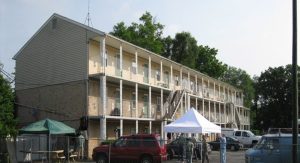Guest Post: The Multifamily Coalition Virginia Needs
Guest Blogger: Chase Counts, CHP Energy Solutions (VAEEC Member – Business Gold)
January 20, 2016

Energy efficiency programs and policies in Virginia have historically favored detached, single-family homes over multifamily housing. For a brief period around 2009, weatherization funds were used on affordable multifamily housing following the influx of federal stimulus money under ARRA; but currently, Virginia’s weatherization program only serves single family housing and only around two-percent of utility funded residential efficiency programs in Virginia go to multifamily housing. Beyond that, few resources have been available to the 385,000 Virginia households residing in affordable multifamily buildings representing about twelve-percent of the commonwealth’s housing stock.
Affirming this imbalance, the national Energy Efficiency For All project identified Virginia as one of 12 states that could cost-effectively increase energy efficiency in the affordable multifamily sector. Leveraging the established reputation and network of Virginia Housing Alliance to lead the charge, a cross-sector group of energy efficiency advocates, weatherization providers, affordable housing providers, and environmental organizations gathered to form the Virginia Multifamily Energy Efficiency Coalition (MFEEC).

The mission of the Coalition is “advancing policies and programs that provide comprehensive energy efficiency services to Virginia’s multifamily affordable housing stock.” The group has set a goal of “25 / 25 / 2025,” which means the coalition will support policies and programs resulting in an average energy savings of 25-percent or greater in 25-percent of the affordable multifamily housing stock in Virginia by 2025.
The Coalition has identified the following opportunity areas to advance towards their goal:
- Weatherization Assistance Program (WAP)
- Utility driven energy efficiency programs
- Legislature
- State Administration
- Financing Mechanisms

Credit: CHP Energy Solutions Research and Training
Since the inaugural meeting in October 2015, Coalition members have established a presence in each opportunity area. Most recently, weatherization service providers participating as contractors for Dominion Virginia Power’s (DVP) prescriptive energy efficiency programs requested the Coalition represent their interests in a negotiation with DVP regarding extending funds to assist with addressing health and safety issues. The Coalition garnered consensus with the providers and submitted a proposal under consideration by DVP currently. A resolution is anticipated early in 2016 that will help keep Virginia households participating in the DVP programs safe and with peace of mind.
The Coalition has also established a work plan to ensure productive discussions turn into meaningful actions with tangible results. The first initiative is establishing a scorecard to track the progress of reaching the goal of reducing the energy burden of nearly 100,000 households within the next 10 years. The second initiative is to host an event in 2016 that will bring together the energy and housing sectors in Virginia and begin to amplify the foundational efforts of the Coalition.
The goals put forward by the MFEEC are ambitious but attainable. The members are driven, passionate, and collectively understand the various policy, regulatory, and technical obstacles and complications that come with a mission of safely and cost-effectively improving energy efficiency of affordable multifamily housing by 25-percent.
If you are interested in becoming a member or for additional information about MFEEC, please visit the website at www.vamfeec.org or contact Zack Miller at zmiller@vahousingalliance.org.
